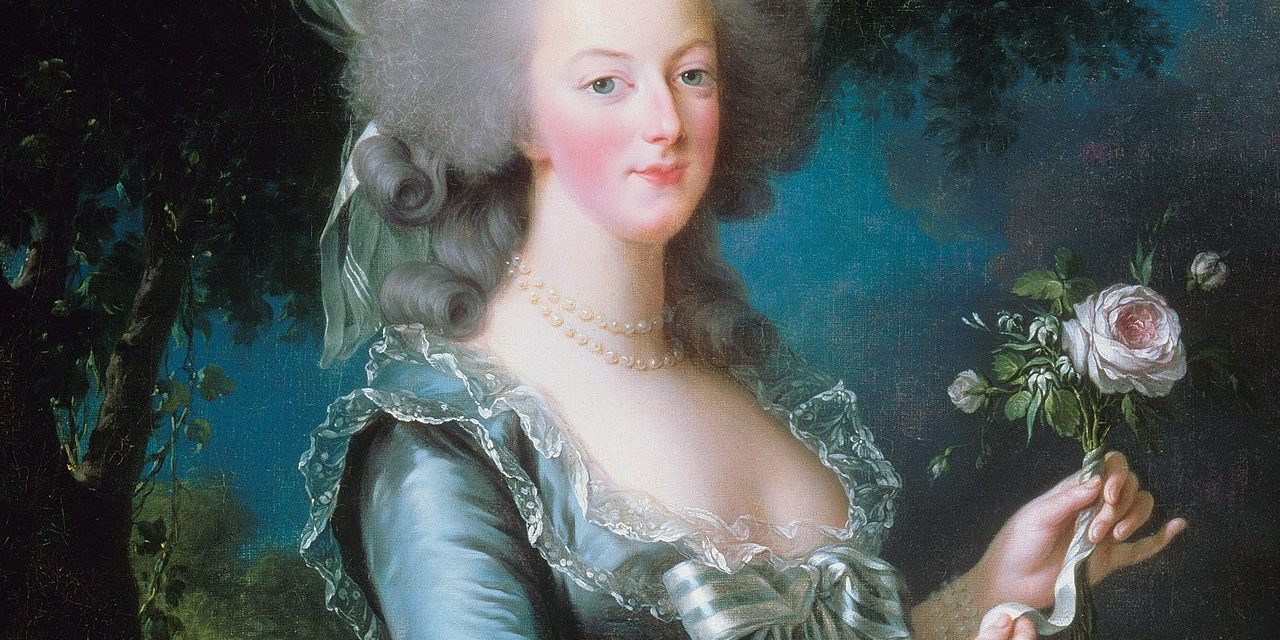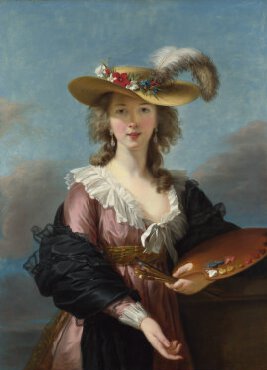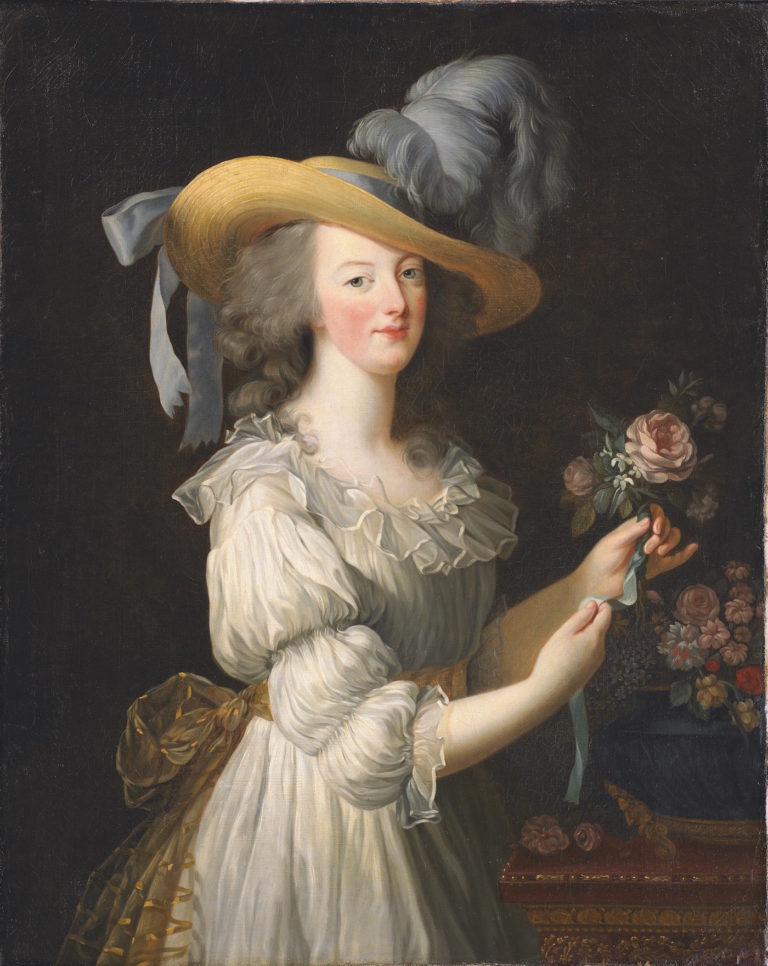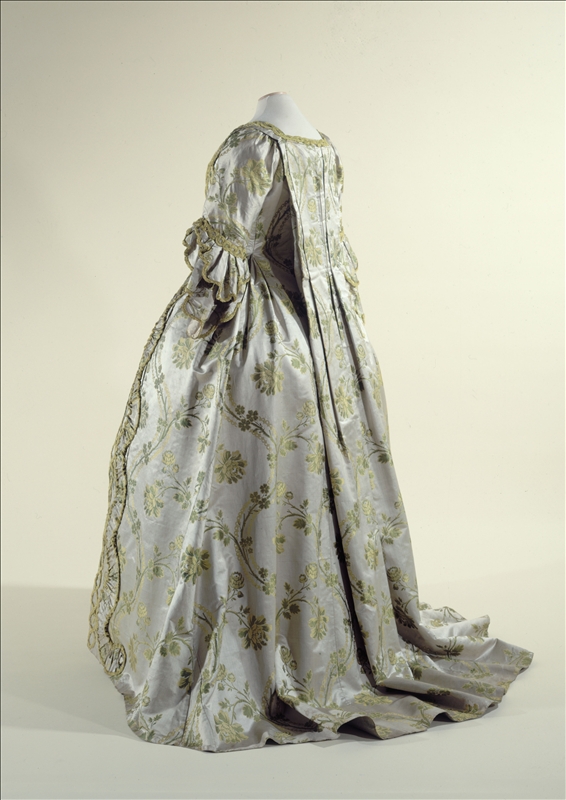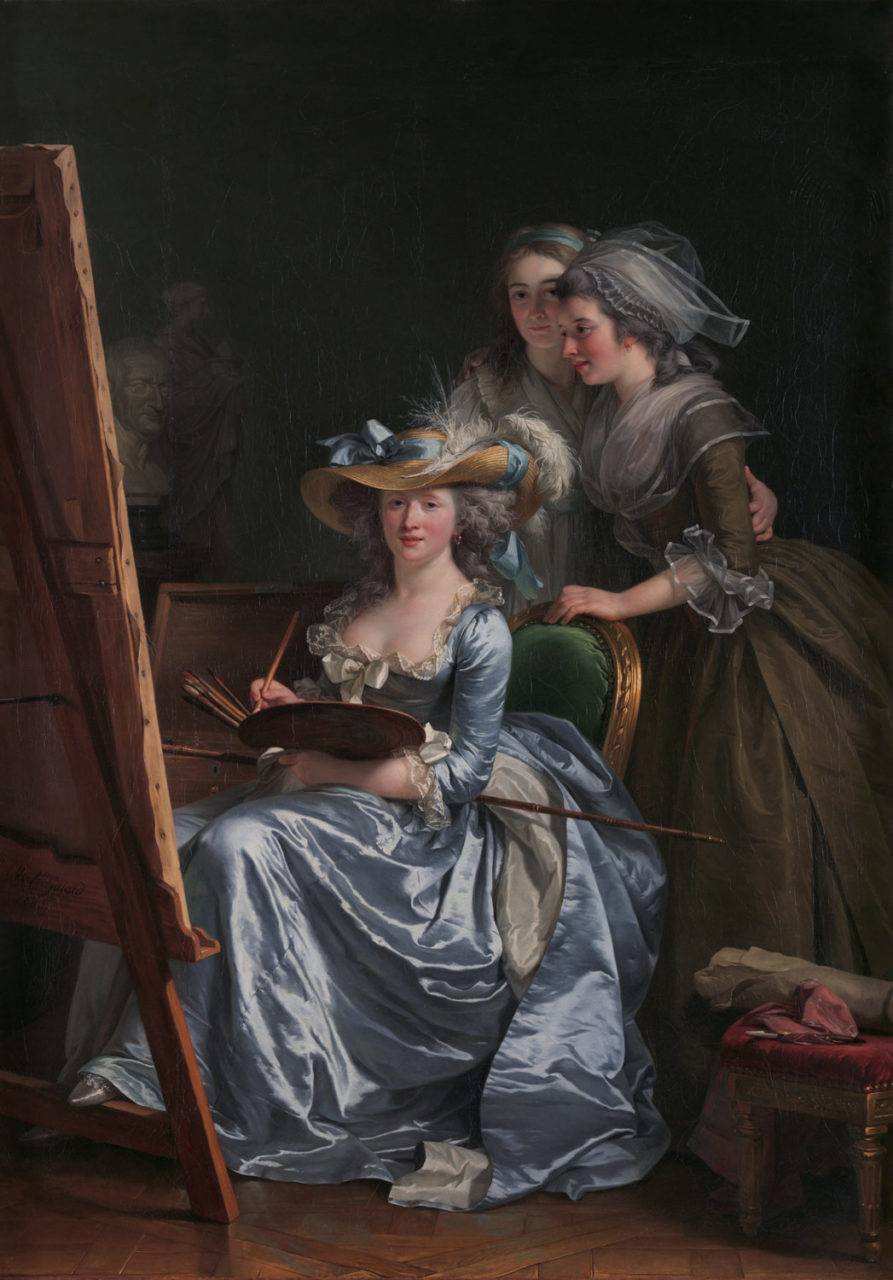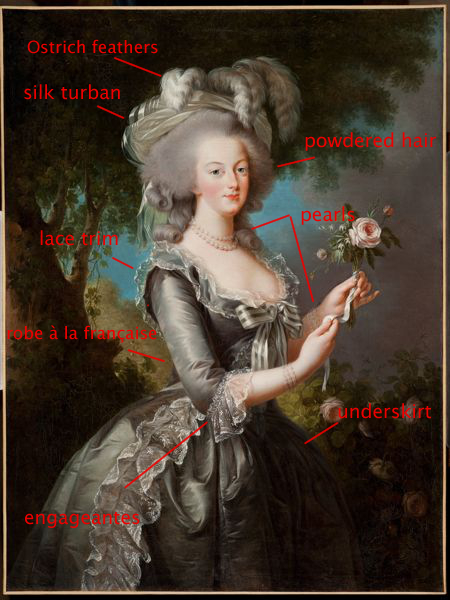Court painter Élisabeth Vigée Le Brun depicts the extremely fashionable Queen Marie Antoinette wearing late 18th-century French aristocratic costume (a robe à la française)–a face-saving portrait after the shock of an earlier fashion faux pas.
About the Portrait
Élisabeth-Louise Vigée Le Brun (Fig. 1) was born in Paris in 1755. By the age of 15, she was already developing herself as an artist, receiving encouragement from painters such as Joseph Vernet. She is associated with the mixture of Rococo and Neoclassical style during the late 18th century. Vigée Le Brun was admitted to the Académie Royale by royal intervention on May 31, 1783. In 1788, she was granted patronage by Marie-Antoinette and became her court painter until the monarchy was abolished (Nicholson).
The sitter is Marie Antoinette (1755-1793) who was born in Vienna as the Duchess of Austria. She was the daughter of Holy Roman Emperor Francis I and Maria-Theresa, ruler of the Hapsburg Empire. She married Louis XVI and entered the French royal family in 1770, becoming the Queen of France (Winter et al.). Antoinette was regarded as one of the most fashionable women of the day due to her extravagant Rococo styles and her ability to set trends. She was interested in the arts and commissioned many portraits, favoring Vigée Le Brun.
This work was painted shortly after a similar portrait commissioned by Marie Antoinette. Vigée had painted Marie Antoinette in a Chemise Dress (Fig. 2) and exhibited it in the Salon but it was heavily criticized for the attire worn by the queen. In Queen of Fashion: What Marie Antoinette Wore to the Revolution (2008), Caroline Weber writes that:
“One irate Salon-goer pronounced that the Vigée-Lebrun portrait ought to have been titled France Dressed as Austria, Reduced to Covering Herself with Straw.” (163)
In response to this outcry, Vigée quickly removed the picture and installed Marie Antoinette with a Rose and changed the attire to “attributes that better attested to both her majesty and her Frenchness” (Weber, 163).
Fig. 1 - Élisabeth-Louise Vigée Le Brun (French, 1755 - 1842). Self Portrait in a Straw Hat, 1782. Oil on canvas; 97.8 x 70.5 cm (38.5 x 27.7 in). London: National Gallery, NG1653. Bought, 1897. Source: National Gallery
Fig. 2 - Élisabeth-Louise Vigée Le Brun (French, 1755 - 1842). Marie Antoinette in a Chemise dress, 1783. Oil on canvas; 89.8 × 72 cm (35 3/8 × 28 3/8 in). Kronberg: Hessische Hausstiftung. Source: The Metropolitan Museum of Art
Élisabeth-Louise Vigée Le Brun (French, 1755–1842). Marie Antoinette with a Rose, 1783. Oil on canvas; 116.8 × 88.9 cm (46 × 35 in). Lynda and Stewart Resnick Collection. Source: The Metropolitan Museum of Art

About the Fashion
Vigée Le Brun had responded to the criticism by painting Marie Antoinette in a blue-gray robe à la française LINK, typical for a French aristocratic woman in this time. In 20,000 Years of Fashion (1987), Francois Boucher describes this garment as a gown with “double pleats on either side of the centre back seam spread the fullness at the back… The bodice is fitted and trimmed in the front with a stomacher” (298). A similar robe à la française in gray silk survives in the Palais Galliera collection (Fig. 3). Marie Antoinette has decorated the front of the gown with a large striped ribbon bow. She wears the gown over an underskirt of the same material, with lace trimmings on both the bodice, overskirt, and at the low neckline. Historian Caroline Weber further describes the dress depicted in the painting:
“This painting represented Marie Antoinette in a blue-gray silk robe à la française and rich pearl jewelry, attributes that better attested to both her majesty and her Frenchness.” (163)
Attached to the dress are lace engageantes, described by Daniel Denis Hill in History of World Costume and Fashion (2011) as “soft, full ruffles… at the cuffs” (439). Marie Antoinette has also paired her dress with a two-tiered necklace of pearls, matching two three-tiered pearl bracelets on either wrist. She wears a white, translucent striped turban trimmed with large plumes most likely from an ostrich. In Europe, ostrich feathers were worn by people of high class, being that ostriches are found in Africa and the feathers were very expensive to import. They were commonly seen on hats of the time, as in figure 4. The queen’s hair is swept back and powdered gray, heightened under the headpiece and with curls that hang down to her shoulders. Hill also describes the hairstyles of the 1780s:
“By the 1780s, coiffures were reduced in height but the volume remained full with masses of untamed curls and long locks in the back.” (447)
It could be inferred that Marie Antoinette wore a petticoat, corset, and chemise underneath her dress. In an article written by Elizabeth McMahon and Lourdes Font, they write about the creator of the dress. It was most likely made by Rose Bertin, Marie Antoinette’s dressmaker and fashion consultant (McMahon and Font).
1780s France embraced both Rococo and Neoclassical styles as the Enlightenment was upon Europe. French high society was living lavishly in the Palace of Versailles. Fashion was reaching extravagant heights in France and Marie Antoinette was the face of it. The dress worn by Marie Antoinette in this painting was not French court fashion, but it was formal attire as opposed to her very informal (and at the time shocking) chemise dresses LINK.
A similar robe à la française is worn by Madame Victoire of France (Fig. 5), and by Adélaïde Labille-Guiard in her Self-Portrait with Two Pupils (Fig. 6). Ironically the formal robe à la française would be discarded with the French Revolution as a distaste for high society led to the fashions of Versailles being discarded. The informal chemise dress that had shocked the public and led to this portrait being created would be widely adopted by the French public in the wake of Marie Antoinette’s execution.
Fig. 3 - Designer unknown (French). Robe à la Française, 1750 - 1760. Satin border, gray and green silk, lining, striped taffeta, green and purple silk, applications of green silk chenille.. Paris: Palais Galliera, musée de la Mode de la Ville de Paris., GAL15611.D.37 A/B. Gift of Don de Madame Bove. Source: Palais Galliera
Fig. 4 - John Hoppner (English, 1758-1810). Portrait of a Lady, ca. 1785-1786. Oil on canvas; 76.8 × 63.8 cm (30.2 x 25.1 in). Melbourne: National Gallery of Victoria, 541-2. Felton Bequest, 1911. Source: National Gallery of Victoria
Fig. 5 - Adélaïde Labille-Guiard (French, 1749–1803). Victoire Louise Marie Thérèse de France, dite Madame Victoire (, 1788. Oil on canvas; 271 cm x 165 cm (106.6 x 64.9 in). Versailles: Palace of Versailles, MV 3960. Source: Chateau Versailles
Fig. 6 - Adélaïde Labille-Guiard (French, 1749–1803). Self-Portrait with Two Pupils, Marie Gabrielle Capet (1761–1818) and Marie Marguerite Carreaux de Rosemond (died 1788), 1785. Oil on canvas; 210.8 x 151.1 cm (83 x 59 1/2 in). New York: The Metropolitan Museum of Art, 53.225.5. Gift of Julia A. Berwind, 1953. Source: The Metropolitan Museum of Art
References:
- “Marie Antoinette with a Rose” Metmuseum.org. Accessed November 08, 2018. https://www.metmuseum.org/art/collection/search/656931.
- Boucher, Francois. 20,000 Years of Fashion. Expanded Ed, 1987. http://www.worldcat.org/oclc/777323433.
- Hill, Daniel Delis. History of World Costume and Fashion. Upper Saddle River, NJ: Pearson Prentice Hall, 2011. http://www.worldcat.org/oclc/768100950.
- McMahon, Elizabeth, and Lourdes Font. Bertin, Rose. Oxford University Press, 2009. http://www.oxfordartonline.com/groveart/view/10.1093/gao/9781884446054.001.0001/oao-9781884446054-e-7002081328.
- Nicholson, Kathleen. Vigée Le Brun [Vigée-Le Brun; Vigée-Lebrun], Elisabeth-Louise. Oxford University Press, 2003. http://www.oxfordartonline.com/groveart/view/10.1093/gao/9781884446054.001.0001/oao-9781884446054-e-7000089458.
- Winter, Patrick M. de, Scot McKendrick, Hilary Ballon, Giles Clifford, Bertrand Jestaz, Mark Stocker, Philip Mansel, et al. Bourbon, House of Family. Oxford University Press, 2003. http://www.oxfordartonline.com/groveart/view/10.1093/gao/9781884446054.001.0001/oao-9781884446054-e-7000010508.
- Weber, Caroline. Queen of Fashion: What Marie Antoinette Wore to the Revolution. London: Aurum Press, 2008. http://www.worldcat.org/oclc/963491098.

